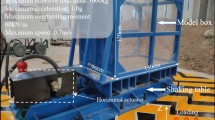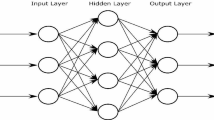Abstract
The relationship of the design peak ground accelerations, earthquake frequency, and seismological conditions of a construction site for a performance-based design has been analyzed. The limitations of using the linear dependence of the repeatability logarithm on the earthquake intensity are given. Recommendations on how the new seismic scale can be used to solve engineering problems in designing structures in seismic areas are given. It is shown that the instrumental part of the new scale is quite acceptable for development of performance-based design. At the same time, in areas with a possible shaking intensity of more than IX, peak ground accelerations lose their importance for assessing seismic resistance, and there is a need to ration the input energy characteristics.







Similar content being viewed by others
REFERENCES
Aggiornamento delle “Norme tecniche per le costruzioni” (18A00716). Ministero delle infrastrutture e dei trasporti. Decreto 17 gennaio 2018, Supplemento ordinario alla “Gazzetta Ufficiale” no. 42 del 20 febbraio 2018, Serie generale, no. 8.
Aptikaev, F.F., Instrumental’naya shkala seismicheskoi intensivnosti (Instrumental Scale of Seismic Intensity), Moscow, Nauka i obrazovanie, 2012.
Areshchenko, T.S., Prokopovich, S.V., Sabirova, O.B., and Frolova, E.D., Setting the level of seismic effect for assessing earthquake resistance of buildings when performance-based design, Prir. Tekhnog. Riski. Bezop. Sooruzh., 2018, no. 4, pp. 25–27.
Birbraer, A.N., Raschet konstruktsii na seismostoikost’ (Earthquake-Resistance Analysis of Constructions), St. Petersburg: Nauka, 1998.
Bogdanova, A.M., Nesterova, O.P., Nikonova, N.V., Tkachenko, A.S., Uzdin, A.M., Rakhmanova, M., Azaev, T.M., and Zainulabidova, Kh.R., Numerical characteristics of seismic effects, Nauka Mir, 2017, no. 3, pp. 49–55.
Divja, B. and Arcumar, C., Evaluation of response reduction factor of irregular reinforced concrete frame structures, Indian J. Sci. Technol., 2016, vol. 9, no. 23, pp. 2–8.
Dolgaya, A.A., Modeling of seismic effect by a short-term process, Seismostoik. Stroit., 1994, nos. 5–6, pp. 56–63.
Dowric, D.J., Earthquake Resistant Design for Engineers and Architects, New York: Wiley, 1977.
Fardis, M.N., Code developments in earthquake engineering, 12th European Conference on Earthquake Engineering, London, U.K., 2002, Pap. Ref. 845.
Ghobarah, A., Performance-based seismic design in earthquake engineering: State of development, Eng. Struct., 2001, no. 23, pp. 878–884.
Gol’denblat, I.I., Nikolaenko, N.A., Polyakov, S.V., and Ul’yanov, S.V., Modeli seismostoikosti sooruzhenii (Earthquake-Resistant Models of Structures), Moscow: Stroiizdat, 1979.
GOST R (National Standard of Russian Federation) 57546-2017: Earthquakes. Seismic Intensity Scale, 2017.
GOST (State Standard) 6249-52: Scale for Determining Earthquake Intensity in the Range from VI to IX, 1952. European Macroseismic Scale EMS-98, Grünthal, G., Ed., ESC, Luxemburg, 1998.
Ingale, C. and Nalamwar, M.R., Performance based seismic design of RCC building, Int. Res. J. Eng. Technol., 2017, vol. 4, no. 10, pp. 618–623.
Khatavkar, A.S., Ghadi, A.P., and Barbude, P.F., Comparative study of response reduction factor for reinforced concrete and steel frame, International Conference on Quality Up-gradation in Engineering, Science and Technology (ICQUEST2015), Maharashtra, India, 2015, pp. 12–14.
Kilimnik, L.Sh., Metody tselenapravlennogo proektirovaniya v seismostoikom stroitel’stve (Methods of Targeted Design in Earthquake Engineering), Moscow: Nauka, 1985.
Moehle, J., Performance-based seismic design of tall buildings in the U.S., 14th World Conference on Earthquake Engineering, Beijing, China, 2008.
Moehle, J. and Deierlein, G.G., A framework methodology for performance-based earthquake engineering, 13th World Conference on Earthquake Engineering, Vancouver, Canada, 2004, Pap. No. 679.
Moskvitin, V.V., Tsiklicheskie nagruzheniya elementov konstruktsii (Cyclic Loadings of Structural Components), Moscow: Nauka, 1981.
Nesterova, O.P., Uzdin, A.M., Sibul’, G.A., Dolgaya, A.A., and Guan’ Yukhai, Universal energy-based characteristic of an earthquake, Prir. Tekhnog. Riski. Bezop. Sooruzh., 2018, no. 4, pp. 23–26.
Newmark, N.M. and Rosenblueth, E., Fundamentals of Earthquake Engineering, Englewood Cliffs, N.J.: Prentice-Hall, 1971.
Park, R. and Paulay, T., Reinforced Concrete Structures, New York: Wiley, 1975.
Riddell, R., Hidalgo, P., and Cruz, E., Response modification factor for earthquake resistant design of short period buildings, Earthquake Spectra, 1989, vol. 5, no. 3, pp. 571–590.
Salem, Y.S., Lomiento, G., and Khan, J., Assessment of Response modification factor of reinforced concrete table top-frame structures to seismic loads, in International Congress and Exhibition “Sustainable Civil Infrastructures: Innovative Infrastructure Geotechnology”, GeoMEast 2017: Facing the Challenges in Structural Engineering, Egypt, 2017, pp. 55–71.
Seismicheskaya sotryasaemost’ territorii SSSR (Seismic Shaking of the USSR Territory), Riznichenko, Yu.V., Ed., Moscow: Nauka, 1979.
Sidorin, A.Ya., Comments on the European Macroseismic Scale (EMS-98) in terms of its applicability in Russia, Seism. Instrum., 2010, vol. 46, no. 4, pp. 377–382.
Smirnova, L.N., Benin, A.V., Semenov, S.G., Uzdin, A.M., and Guan’ Yukhai, Estimation of reduction coefficient for designing bridge supports, Seismostoik. Stroit. Bezop. Sooruzh., 2016, no. 6, pp. 15–19.
Sosnin, A.V., On specifying the coefficient of acceptable damages K1 and its consistency with the concept of seismic forces reduction in statement of the spectral method, Vestn. Grazhdanskikh Inzh., 2017, no. 1, pp. 92–114.
SP (Design Code) 14.13330.2014. Building in Regions Prone to Earthquakes. Updated Version of SNiP II-7-81*, 2014.
Sy, J.A., Anwar, N., HtutAung, T., and Rayamajhi, D., Performance based seismic design state of practice, 2012 Manila, Philippines, Int.J. High-Rise Build., 2012, vol. 1, no. 3, pp. 203–209.
Ulomov, V.I. and Bogdanov, M.I., A new set of maps of general seismic zoning for the territory of Russian Federation (GSZ-2012), Inzh. Izyskaniya, 2013, no. 8, pp. 30–39.
Uzdin, A.M., What lies behind the linear-spectral theory of seismic resistance, Seismostoik. Stroit. Bezop. Sooruzh., 2009, no. 2, pp. 18–23.
Uzdin, A.M., Elizarov, S.V., and Belash, T.A., Seismostoikie konstruktsii transportnykh zdanii i sooruzhenii. Uchebnoe posobie (Earthquake-Resistant Constructions of Transport-Related Buildings and Facilities: A Textbook), Moscow: Uchebno-Metod. Tsentr Obraz. Zheleznodorozhn. Transp., 2012.
ACKNOWLEDGMENTS
The authors thank Prof. F.F. Aptikaev for consultations and help during the preparation of the manuscript.
Author information
Authors and Affiliations
Corresponding author
Ethics declarations
The authors claim no conflict of interest.
Additional information
Translated by N. Astafiev
About this article
Cite this article
Nazarova, S.S., Uzdin, A.M. Setting Peak Ground Accelerations for Performance-Based Design of Earthquake-Resistant Constructions. Seism. Instr. 56, 225–236 (2020). https://doi.org/10.3103/S0747923920020085
Published:
Issue Date:
DOI: https://doi.org/10.3103/S0747923920020085




